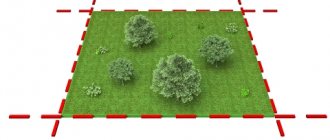Ownership of land is confirmed by special title documents and cannot be limited without compelling reasons.
However, the state or municipal authorities may limit the rights to use and dispose of land if the resources are of particular value to the country.
Land reservation is not the withdrawal of land from use, it is only a procedure preceding the withdrawal. The fact of seizure may not take place if the need for land resources disappears over time.
During the reservation process, restrictions are imposed on the registration of land ownership, the reconstruction of existing facilities or the construction of new ones in order to solve local or federal government problems.
What is a site reservation?
Reserving a land plot is the imposition of restrictions on the use of the plot by the owner due to the high probability of its further exploitation for the benefit of the country. The territory is considered reserved only after registration in Rosreestr of the fact that the land is assigned to the state.
The restriction may apply to lands owned by private individuals. This conflicts with the Constitution, because private property in the Russian Federation is inviolable. However, this rule does not apply when it comes to economic security or the defense capability of the state.
The reserved lands will be alienated from the owner, but on a compensation basis - the state will buy them.
When reserving a specific plot of land, authorities are required to notify its owner that certain work is planned to be carried out on this plot.
Next, an assessment examination is carried out. Upon completion, the land is considered pre-reserved. She will lose this status in one of two cases:
- the procedure for purchasing the plot will begin;
- the need for redundancy will disappear as a result of the revision of strategic plans.
In this case, it is necessary to take into account the established maximum period for booking the plot.
Restriction of rights of owners
Article 40 of the Land Code of the Russian Federation provides for the rights of land owners. In accordance with Art. 56.1 of the said code, the rights of owners may be limited in connection with the reservation of land for state or municipal needs.
Restrictions on the rights of owners are established in the Reservation Decision. The following types of restrictions are usually established:
- registration of land plots into private ownership;
- construction of new buildings and structures;
- reconstruction of existing facilities.
These restrictions are created in order to limit the increase in the redemption value of real estate in the event of their seizure.
These restrictions are subject to state registration with the Office of Rosreestr of the Russian Federation. In the future, after registration, the details of the reservation decision will be indicated in the extract from the Unified State Register of Real Estate in the “Restrictions” column.
————————-
Important : If the owner independently builds a new property or reconstructs an existing one during the reservation period, then in the event of seizure of the land plot, the owner will be reimbursed only for those objects that were created and registered before the reservation.
————————-
Why does the state reserve land?
There are many reasons for state reservation, so every land owner needs to be prepared for the fact that the procedure for reserving an allotment can begin at any time. The list of main reasons is specified in Article 49 of the Land Code of the Russian Federation:
- Grounds related to construction or reconstruction:
- engineering systems of hot and cold water supply, gas and electricity supply:
- linear facilities ensuring the functioning of natural monopolies and the space industry;
- infrastructure facilities for road and railway transport;
- state security and national defense facilities;
- energy systems and nuclear energy facilities.
- Grounds related to the fulfillment of obligations assumed by Russia under interstate treaties.
Reservations are also necessary when creating reservoirs, organizing environmental protection zones, and equipping special facilities that form the infrastructure of the SEZ (Special Economic Zone).
Grounds for reserving territory
Article 49 of the Land Code highlights the main reasons that serve as the basis for reserving land.
First of all, the reason for assigning territory to a state may be the need to fulfill international agreements and obligations of the country. In addition, the reserve of land plots is carried out in the event of construction, transformation within their borders or near them the following objects:
- energy systems of regional or federal scale;
- nuclear energy operating facilities;
- objects related to the defense and security of the Russian Federation, including technical structures, communications, systems erected to protect the borders of the state;
- transport and communication facilities of both regional and federal significance, as well as public railway systems;
- space objects;
- objects of cold and hot water supply systems, sewerage systems, as well as heat supply systems, gas supply and electrical networks;
- highways.
Territories are subject to reservation only if there are no other options for the construction of objects of state or regional importance. At the same time, the law stipulates that in the list of reasons for reserving land owned by constituent entities of the Russian Federation or in municipal ownership, other options based on newly emerged circumstances are acceptable.
It is worth adding that lands considered the property of the state and local authorities are assigned to them and are not provided for use by third parties if social, transport and engineering infrastructure facilities are located on them. In addition, the reserve includes territories with structures erected on them for the safety and protection of the country, as well as areas allocated for the creation of protected natural sites and water structures.
How is land reservation carried out?
The procedure for reserving land plots for municipal needs is regulated by Government Decree No. 561 of July 22, 2008. According to this document, the right to make a decision on transferring a site to the reserve fund is vested in the executive authority of the local, regional or federal level at the location of the facility.
The decision is made based on data from the state real estate cadastre. Consequently, reserving land is unacceptable if the plot is not registered in the cadastral register and does not have an individual number and passport.
To transfer land to the reserve fund, the following documents are required:
- on territory planning, if the plot is intended for the construction of environmental structures or defense and security facilities;
- containing information about the boundaries of the zones of the proposed location of objects in the reserved territory;
- confirming the fact of booking the plot in accordance with state programs, the purpose of which is the rational use of the territory and the study of subsoil.
After reviewing the documents, the authorized body issues a reservation of the territory in the form of a separate act. It contains:
- information about the purposes of the reservation;
- deadlines for completing the procedure;
- list of documents taking into account which the reservation is made;
- cadastral numbers of all plots located within the boundaries of the reserved territory.
The final restriction of rights to reserved plots with their subsequent registration with the state is formalized by sending the above papers to the State Register. This decision becomes valid only after publication in regional media.
Authorized bodies
The decision to reserve land for state and municipal needs is made by the authorized body, depending on the level of the facility being located.
So, when placing objects of federal significance , such as:
- federal transport;
- national defense and state security;
- energy;
- higher education;
- healthcare,
the decision is made by the federal executive body. For example, the Government of the Russian Federation.
When placing objects of regional significance , such as:
- transport;
- prevention of intermunicipal and regional emergencies, natural disasters, epidemics and liquidation of their consequences;
- education;
- healthcare;
- energy;
- physical Culture and sport,
the decision is made by the executive body of the constituent entity of the Russian Federation . For example, the Government of the Sverdlovsk region.
When placing municipal facilities , such as:
- electricity, heat, gas and water supply to the population, sanitation;
- local roads;
- education;
- healthcare;
- physical culture and mass sports;
- processing, recycling, neutralization, disposal of municipal solid waste,
the decision is made by the local government . For example, the Administration of the city of Yekaterinburg.
Acceptable terms for land reservation
Article 70.1 of the RF Land Code states that:
- lands for municipal and state needs can be reserved for a period not exceeding 3 years;
- lands owned by federal or local authorities, and those on which it is planned to create a special economic zone, are reserved for a period of up to 2 years. To do this, the reservation application must indicate the decision of the highest government body of the administrative-territorial unit of the Russian Federation;
- For a period of up to 20 years, plots owned by federal or local authorities can be reserved for the construction and reconstruction of: federal highways;
- metro transfer hubs;
- objects of air, railway, sea and inland water transport and so on.
Translation instructions
Changing categories is almost identical. The features of the change are a consequence of the previous category of the site. For reserve lands, it is necessary to perform preliminary site formation. What is site formation?
- The formation of a plot requires the participation of a cadastral engineer, who will record the boundaries of the land plot. Engineers' services are paid for by a person authorized to draw up the relevant documents.
- Drawing up a plan for the location of the site.
- Entering the site into the cadastre.
Reserve lands are subject to state registration, but do not have agreed boundaries with other owners. Areas where the formation of plots is not permitted:
- Territories crossing the boundaries of cities, towns and other populated areas.
- Lands include protected areas with water bodies, forests, etc.
The formed site should not violate urban planning regulations with its size and intended use. To change the category you need to submit an application and collected documents. Contents of the application:
- Information from the cadastral passport.
- Information about the category (initial and desired).
- Current extracts from the register, which certify the absence of the right holder, the form of ownership in which the lands are located.
- . Copy of the passport.
- A copy of the representative's passport and power of attorney.
- An extract from the register certifying the absence of rights to the site.
All collected documents are used to conduct a state environmental assessment. In most cases, the reserve lands did not exist as land plots, so there is no need to change the category. They receive their initial category by decision in the form of an act before marking the boundaries of the plots.
Rights of plot owners
Although the use of land is intended to solve problems at the state or regional level, this does not negate the requirement to ensure the protection of the interests of the owners of the reserved plots.
However, this does not apply to non-privatized plots. Their owners usually face the following restrictions:
- Reserved lands cannot be privatized;
- the construction of commercial facilities and residential buildings is not allowed, since their cost in the event of seizure most likely will not be compensated;
- It is prohibited to build irrigation structures intended for land reclamation work and other objects.
In the event of losses arising from the reservation of a land plot, its owner may file a claim for compensation in court.
Termination of reserve
Not all reserved territories will actually be withdrawn from circulation in the future . Such a need may simply cease to be relevant over time.
The selected territory may be replaced by another plot of land that is more suitable in terms of characteristics. In addition, the entire reserve has an expiration date. When the period comes to an end, the land reservation is canceled.
Reservations may be terminated:
- Upon expiration of the reserve period specified in the decision.
- The plot has already been provided for state or municipal needs.
- The body that made the decision on the reservation canceled it due to the discovery of a more suitable site or due to the cessation of the planned activity.
- The site was seized legally.
- The reservation was canceled by a court decision.
The body involved in reserving land, upon termination of the reserve, must necessarily transfer the relevant information to Rosreestr in order to change the record of the reserve existing there.
Land requisition
Requisition acts as one of the grounds for confiscation of property from the owner. It differs from confiscation in that:
- is applied forcibly not as a cartel measure, but only because of an urgent need;
- The procedure is of a paid and temporary nature.
Requisition of a land plot is carried out on the basis of a statement published by the Government of the Russian Federation about the occurrence of emergency situations in a specific region of the country or a decision made by an authorized body.
The purpose of the procedure is to protect people, society and the state from the negative consequences of disasters. Expenses incurred by a person are compensated from the state budget.
Read more information on this topic in the article “Requisition of land”.
Let's sum it up
Land reservations are made to ensure that they are not used for other purposes or transferred to individuals and legal entities. The legislator has established a special procedure, which assumes that actions are carried out by a body that has the authority to dispose of land plots. The reserve is applied in strictly specified cases and can sometimes be canceled at the request of the interested party.
Read: Extension of a land lease agreement
On the rules for development and use of land
In the context of the issue under consideration, it is useful to familiarize yourself with the Development and Land Use Rules (hereinafter referred to as the DRL). According to the Town Planning Code, the PZZ is a town planning zoning document approved by the local government body. It installs:
- town planning regulations;
- territorial zones;
- the procedure for applying and making additions and changes to the document.
The territory of the municipality, in accordance with the PZZ, is divided into zones for various purposes:
- residential,
- production,
- social and business and so on.
For any of the zones, the types of permitted use of capital construction objects and land plots are determined. For example, the territory may not be subject to development at all.
Details are contained in the article “Rules of development and land use”.
Change of land category
The method of changing the category is standardized by law and described by regulatory documents. According to which there is a certain procedure:
- Determination of the authority that decides on the target change in the use of the site.
- Preparation of an application and collection of documents.
- Registration of property rights, taking into account the main purpose of the territory.
Legislation has changed frequently, resulting in confusion and lack of data. If there is a lack of cadastral data, they are taken from documents certifying ownership. The issue of the category of a site is initiated by the owners, and the decision to assign a category is made by the authorities.
If the necessary information is not provided by the land act, certificate and cadastre, then the purposes of land use are determined by the local council.
Changes in the cadastre are made free of charge, and a fee is paid for amendments to the register. The authority to assign and change the category of state lands in Moscow and St. Petersburg, and change the boundaries of plots belongs to the Federal Government.
In other cases, the use of reserve lands and their transfer to another category are regulated by municipal or regional authorities. Regional authorities can transfer rights to the municipal level.
ATTENTION! The transfer of plots belonging to district or city territories to other settlements is carried out by local authorities, if the lands were within their boundaries before 01/05/2005.
It should be noted that changes regarding village and intra-city areas are carried out by decision of local authorities. The lands are managed by the municipality. Owners and landowners are not involved in resolving the issue.
The rules apply to regions where land is not divided between federal and regional authorities. If division exists, then the unused lands are at the disposal of the relevant authority.
The procedure for the seizure of plots for state and municipal needs
Land plots can be confiscated forcibly or voluntarily. The last option involves concluding an agreement on the purchase of the plot between an authorized representative of the municipality and the owner.
When determining the cost of a plot, the following are taken into account:
- market price;
- the amount of losses incurred by the owner due to moving to another location;
- the value of the property located on the land.
The period during which the local authority is obliged to notify the copyright holder about the seizure does not exceed 1 week from the date of making a decision on this issue. The draft contract for the purchase of the plot must indicate the estimated cost.
The land owner is given 3 months to study the nuances. The transfer of the plot to the municipality or the state earlier than the specified period of time can only be carried out with the consent of the owner.
For those who are interested in this topic, we recommend studying the article “Confiscation of land for state and municipal needs.”
Cancel reservation
The decision to reserve a land plot can be canceled through the court if there are good reasons for doing so. Usually, an interested party who had plans for a given land plot or who considers the decision made on the reserve to be illegal, files a claim in court.
A claim filed with the court must contain the following information:
- information about the plot of land, its characteristics;
- the grounds on which the site was reserved;
- grounds on which the site cannot be used as a reserve.
You can get a positive decision on canceling the reserve if you prove that there are other territories suitable for fulfilling the purposes of the reserve, or prove non-compliance with the procedure for reserving land. In other cases, with a high degree of probability, the court will accept the position of state or municipal authorities.
Land reservation is used to protect plots from being transferred to other owners or from being used for other purposes . Reserved lands are of particular interest to state or municipal authorities, therefore they are withdrawn from possession and use on legal grounds, but only if they cannot be replaced by other land territories.
Tax accounting of reclamation costs
The Tax Code of the Russian Federation prescribes differentiating the time for land reclamation depending on the method of use that led to their violation:
- Development of natural resources. If the organization’s activities were related to the direct use of land, then for tax purposes, reclamation costs are written off evenly over 5 years. Grounds – Art. 261 of the Tax Code of the Russian Federation and explanatory letters of the Ministry of Finance of the Russian Federation dated March 28, 2007 No. 03-03-06/1/177 and dated November 13, 2006 No. 03-03-04/1/754.
- Other activities. If the land was not used for its intended purpose, but was damaged, the costs of its reclamation should be classified as material costs. Reason – subclause 1 of clause 7 of Art. 254 of the Tax Code of the Russian Federation, there is also a corresponding judicial precedent - resolution of the Federal Antimonopoly Service of the Moscow District dated November 27, 2009 No. KA-A40/11724-09, dated July 23, 2009 No. KA-A40/7049-09.
ATTENTION! It is important for companies paying the unified agricultural tax to distinguish between reclamation after land development and other causes of soil fertility disturbance. In the first case, reclamation costs for the Unified Agricultural Tax are not taken into account. In the latter case, when calculating the single tax, reclamation costs must be taken into account as part of material costs (Article 346.5 of the Tax Code of the Russian Federation).
What is reclamation
Any enterprise is, to one degree or another, an invasion of the environment. Some industries have a greater impact on the topsoil than others, so they are required to take extra care. If cultivation is human intervention in the natural processes of soil formation and using them for one’s own purposes, then reclamation artificial measures to restore the fertility of the soil layer. This is done in three main ways:
- preventive measures to prevent the negative consequences of production for the environment, in particular for the land (soil);
- eliminating the consequences of soil damage and contamination;
- taking measures to conserve and enrich land resources.
REFERENCE! Reclamation is carried out where the land has been so changed under the influence of production factors that it is no longer suitable for fertility. If the land is only partially depleted, radical improvement is carried out instead of reclamation.
Reclamation costs
According to the regulations established by the state, reclamation takes place in 2 phases:
- technological - leveling the relief: filling pits, pits, ruts, ravines, etc. with the removal of non-biological waste;
- biological - renewal of the fertile soil layer (usually applied from outside).
As we can see, these are large-scale events that require significant expenses from the organization. Where to get these funds and how to use them for accounting or tax purposes?
The Tax Code does not include provisions for accounting for reclamation costs.
Accounting for these costs is mandatory in the project documentation of a company using land (soil and/or subsoil) as part of environmental protection measures.










